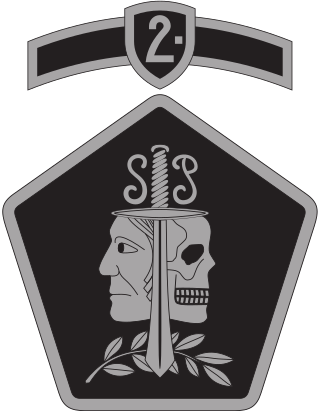
A municipality is the smallest administrative subdivision of Estonia. Each municipality is a unit of self-government with its representative and executive bodies. The municipalities in Estonia cover the entire territory of the country.

Harju County, is one of the fifteen counties of Estonia. It is situated in Northern Estonia, on the southern coast of the Gulf of Finland, and borders Lääne-Viru County to the east, Järva County to the southeast, Rapla County to the south, and Lääne County to the southwest. The capital and largest city of Estonia, Tallinn, is situated in Harju County. Harju is the largest county in Estonia in terms of population, as almost half (45%) of the Estonia's population lives in Harju County.

Ida-Viru County is one of 15 counties of Estonia. It is the most north-eastern part of the country. The county contains large deposits of oil shale - the main mineral mined in Estonia. Oil shale is used in the production of shale oil and in thermal power plants. The capital of the county is the town of Jõhvi which is administratively united with the Jõhvi Parish; nevertheless, Narva is the largest town in the county in terms of population and at the same time the third largest city in Estonia after Tallinn and Tartu.

Järva County is one of 15 counties of Estonia. It is situated in the central part of the country and borders Lääne-Viru County to the east, Jõgeva County to the south-east, Viljandi County to the south, Pärnu County to the south-west, Rapla County to the west, and Harju County to the north. In January 2009, Järva County had a population of 29,940 – constituting 2.7% of the total population in Estonia.

Saare County is one of 15 counties of Estonia. It consists of Saaremaa, the largest island of Estonia, and several smaller islands near it, most notably Muhu, Ruhnu, Abruka and Vilsandi. The county borders Lääne County to the east, Hiiu County to the north, and Latvia to the south. In 2022 Saare County had a population of 31,292, which was 2.4% of the population of Estonia.

Lääne County is one of the 15 counties of Estonia. It is located in western Estonia and borders the Baltic Sea to the north, Harju County to the north-east, Rapla County to the east, Pärnu County to the south, and the island counties of Saare and Hiiu to the west. In January 2009 Lääne County had a population of 23,810 – constituting 2.0% of the total population in Estonia.

Jõgeva County is one of 15 counties of Estonia. It is situated in eastern part of the country and borders Ida-Viru County to the north-east, Lake Peipus to the east, Tartu County to the south, Viljandi County to the south-west, Järva County to the north-west and Lääne-Viru County to the north.

Valga County is a first-level administrative unit and one of 15 counties of Estonia. It comprises the former area of Valga District. The present-day county was created on 1 January 1990. The capital and largest town of Valga County is Valga, followed by Tõrva and Otepää. It is situated in the southern part of the country and borders Põlva and Võru County to the east, Latvia to the south and west, and Viljandi and Tartu County to the north. 27,650 people live in Valga County as of 2022.

Ugandi was an independent county between the east coast of Lake Võrtsjärv and west coast of Lake Pskov, bordered by Vaiga, Mõhu, Nurmekund, Sakala, Tālava, and The Principality of Pskov. Ugandi had an area of approximately 3000 hides. Ugandi corresponded roughly to the present Estonia's territory of Võru County, Põlva County and half of Tartu County and Valga County, as well as Petseri County.
The flags of the 15 counties of Estonia are all white and green, with the coat of arms of the respective county on the white part. This design was first established in 1938. The list also includes the historical flag of Petseri County, which in 1944 was occupied by Soviet forces and became Pechorsky District in Pskov Oblast, present-day Russia. The district was claimed by Estonia after the re-establishing of independence in 1991, but the claim was dropped in 1995. The county governments along with county governors were abolished with the 2017 administrative-territorial reform, and their tasks were transferred to ministries, so it is unusual to see these flags in use nowadays.
The coats of arms of the 15 counties of Estonia are presented below.

Ancient Estonia refers to a period covering History of Estonia from the middle of the 8th millennium BC until the conquest and subjugation of the local Finnic tribes in the first quarter of the 13th century during the Teutonic and Danish Northern Crusades.
Reval Governorate was an administrative-territorial unit (guberniya) and one of the Baltic governorates of the Russian Empire, which existed from 1719 to 1783. Its capital was in Reval (Tallinn).

The Omakaitse was a militia organisation in Estonia. It was founded in 1917 following the Russian Revolution. On the eve of the occupation of Estonia by the German Empire, the Omakaitse units took over major towns in the country allowing the Salvation Committee of the Estonian Provincial Assembly to proclaim the independence of Estonia. After the German Occupation the Omakaitse became outlawed.

The following is an alphabetical list of articles related to the Republic of Estonia.

The 2nd Infantry Brigade is an infantry brigade of the Estonian Land Forces. It is the primary military unit in Southern Estonia. The brigade headquarters is currently based at Sirgu village, Luunja Parish, Tartu County. The brigade is tasked with planning and organizing military operations, planning and organizing mobilization, ensuring the readiness and support of its subordinate units, preparing wartime reserve units and their formation, organizing the training and participation in international military operations.
Anton Lembit Soans was an Estonian architect, urban planner and lecturer. He was one of the founding members of the Estonian Architects Union.
















